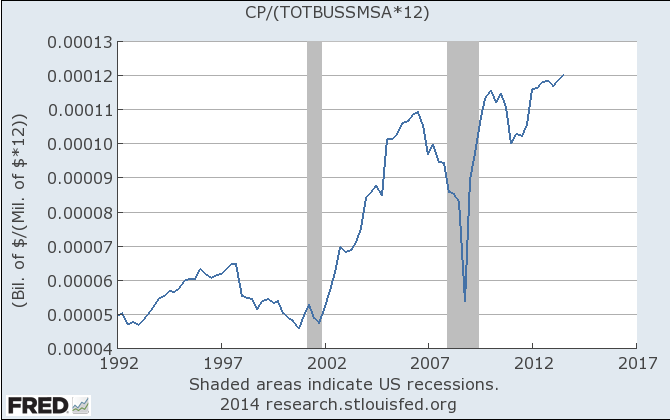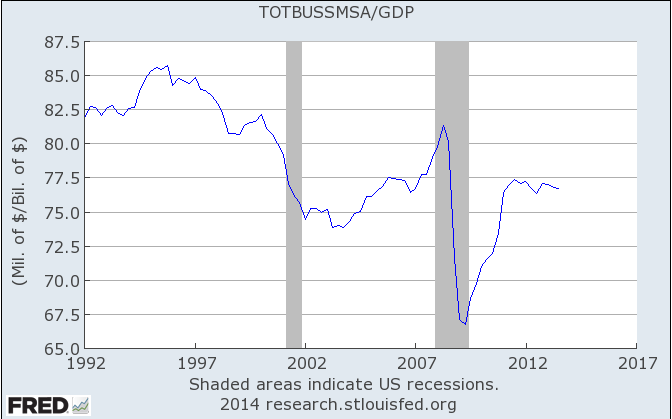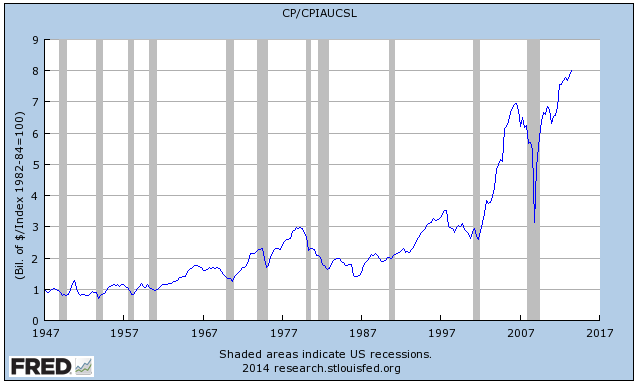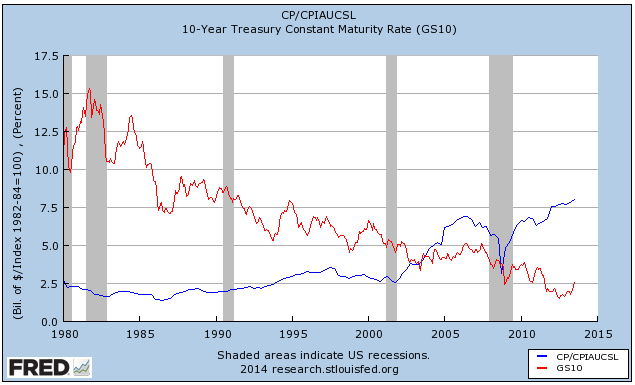I have just read John Mauldin’s warning that the market is overvalued:
Not only does today’s CAPE of 25.4x suggest a seriously overvalued market, but the rapid multiple expansion of the last few years coupled with sluggish earnings growth suggests that this market is also seriously overbought, as I pointed out last week and as we are seeing play out this week.

Robert Shiller’s CAPE ratio compares the current index price to a 10-year simple moving average of inflation-adjusted earnings in order to smooth out earnings and provide a long-term indication as to whether the market is under- or over-valued. But ratios are far from infallible. One of the first things fundamental investors/traders learn is: do not buy a stock simply because the Price-to-Earnings (PE) ratio is low, and never short a stock simply because the PE ratio is high. The reason is fairly obvious. In the first case, current earnings may be expected to fall and, with high PE ratios, earnings are likely to grow.
Let’s examine CAPE more closely. First, we have experienced the worst recession in almost a century; so does a moving average of the last 10 years adequately reflect sustainable long-term earnings? In the chart below I removed the highest and lowest quarter’s earnings in the last 10 years [dark green]. Note the visible difference losses reported in Q/E December 2008 make to the long-term average.

The chart also highlights the fact that Shiller’s CAPE is relatively low compared to the last 15 years, where the average is close to 30. The normal PE of 18.4, calculated on the last 12-month’s earnings*, is also low compared to an average of 28 for the last 15 years.
*Reporting for the December quarter is not yet completed and unreported earnings are based on S&P estimates.
As novice investors learn, it is dangerous to base buy or sell signals on a PE ratio, whether it is CAPE or regular PE based on 12-months earnings. Using CAPE, we would have sold stocks in 1996 and again in 2003, missing two of the biggest bull markets in history. And we would have most likely bought in 2008, when CAPE made a new 10-year low, right before the collapse of Lehmann Brothers.
I submit that CAPE or PE ratios are not an end in themselves, but merely a useful tool for highlighting expectations of future earnings. At present both ratios are rising, suggesting that earnings prospects are improving.

Did I miss the definition of “CAPE”?
“Robert Shiller’s CAPE ratio compares the current index price to a 10-year simple moving average of inflation-adjusted earnings in order to smooth out earnings and provide a long-term indication as to whether the market is under- or over-valued.”
Thank you for helping to make better sense Of Mauldin’s cape comments
The second chart clearly says S & P 500 but the first chart going back before 1900 has no title so I have no idea about what and how many companies were included and whether the number of stocks changed. Also in the discussion of the second chart it states that ’30’ is the average whereas the first chart says that 25 is high. Therefore I understand what you are getting at but can’t really determine what ‘high’ is.
Quite correct. The S&P 500 was not around in 1881. I am assuming that Shiller used a wide enough spread of stocks to obtain an accurate reflection of price and earnings.
The CAPE value of 25.36 is not the high, but the latest value according to the graph. The average since 1881 would be a lot lower. But the average for the last 15 years is close to 30. This suggests that earnings expectations are rising.
Germany’s Klaus Singer provides a linear regression channel of CAPE at http://www.timepatternanalysis.de/Blog/2014/01/05/aktien-2014/:
I would not even grant that higher CAPE or PE ratings do suggest “that earnings prospects are improving”. The price of a stock – which is one component of the PE – indicates nothing other than what the market is paying. It cannot with any legitimacy be held to be accurate as a forecast of anything.
The other half of the PE ratio is related to earnings. The market is prepared to pay a higher price for stocks when earnings prospects are good, compared to when they are bad. Whether the market is correct in its expectations is, I will grant, open to debate.
From Twitter: @EddyElfenbein Jan 22
81 stocks in the S&P 500 have reported so far; 70% beat on earnings and 64% beat on sales.
Colin, a log chart of the Dow for the past 25 years displays a massive megaphone formation with the index currently coming off the all time high of just on 16,600 while also showing a potential downside target of around 6,000. Languishing bond rates in Europe, the US and Japan, QE tapering, worrying sovereign debt levels and a slowing China give support to the notion that equity markets could be on the slide for some time to come.
Peter
Be careful of confirmation bias. One needs to weigh up the evidence for and against — and not just look for evidence that supports one side of the debate.
Colin – very thankful for your kind provision of this information, and your related actions and comments. All the best.
Rather than CAPE would it not be possible to estimate earnings say 3 years ahead
and then apply various multiples to see if the market is overvalued or not?
With hindsight was not SPX a steal at 800 a few years ago? The hindsight
cop out is an excuse for lack of foresight!
Difficult to estimate earnings so far ahead. There are so many variables.
Corporate Profits to Business Sales:

Business Sales to GDP:

A better approach may be to use Benjamin Graham’s margin of safety. Calculate what profit growth is required to match the (long-term) risk-free rate of return. How certain are we of achieving this rate? If the long-term risk-free rate is say 5% after tax and inflation, and the dividend yield is 2% after tax, how certain are we of achieving long-term growth in corporate profits of 3% above the rate of inflation and after (capital gains) tax?
Corporate Profits over CPI:

Compound growth is 6.6% (after inflation but before tax) if measured from 1987, but only 4% if measured from 1960. Even the lower rate is likely to meet the 3% after tax target rate.
This revealing analysis was published by Steve Sjuggerud:
What most people don’t know is there is a strong relationship between interest rates and stock market values… This table shows what I mean:
P/E Ratio % of the Time
Average P/E of all periods since 1950 = 17.8
Average P/E when rates are above 6% + 12
Average P/E when rates are below 2.5% + 21.8
As you can see, when interest rates are high, stocks are usually cheap at a P/E ratio of just 12. But when rates are low, stocks trade for much higher average P/E ratios… nearly 22.Today, interest rates are incredibly low, near zero. Yet stocks trade for a P/E ratio of just 16.8. That’s below their long-term average P/E ratio… and well below the 22 P/E ratio they could trade for based on the table.
He thinks this history indicates that stocks have much further to rise.
Thanks David. I agree there is a strong relationship between corporate profits and interest rates. Low rates may be contributing to higher profit growth since the 1980s.
Corporate Profits (adjusted for inflation) compared to 10-year Treasury Yields:

I should have adjusted the 10-year yield for inflation as well, but FRED has its limitations.
Is it not now that the significantly below-average PE of 16.8, given current very low interest rates, is indeed an indicator that the interest rate effect on prospective corporate earnings has diminished markedly from our historical experience – that is, declining interest rates now do not result in sustained upward momentum to corporate profits and gross domestic product to an extent similar to the past experience (perhaps the only sluggish improvement in USA unemployment rate over the current 5 year period of heavily depressed interest rates supports this view)
So, looking forward, is the market currently pricing prospective earnings at an expensive multiple, given a significantly changed interest rate/corporate earnings relationship?
If above is the case, then is it really true that ‘stocks have much further to rise’ ?
Does Dr Shiller’s graph not become very compelling, if the above taken into account?
you say the worst recession in almost a century. Not in Australia. We are more than 20 years overdue for a recession. I realise you are talking about the S&P and global markets as a whole. But that being said I amazed at the performance of Australia especially the property market. We now have a whole generation of people in the workforce who have never experienced a recession. These are the same people who are buying a property with 5% equity if that. Heaven help them if interest rates ever get back to double figures
Addlett –
1. We had quite a major economic shock in the GFC – tantamount to a recession. So, not quite true that “we are more than 20 years overdue for a recession”.
2. Also, interest rates positively correlated with inflation , the latter firmly under wraps worldwide ; so, no major unexpectedly nasty interest rises are foreseen ( refer your ” Heaven help them…..)
3. Furthermore, given paragraph 2. above, it shows wisdom to borrow as much as possible when funding an appreciating asset in low interest rate scenario, as else unchanged. Good on those you play out this apparent wisdom, buy buying property with 5% equity.
4. Given paragraph 2, the stockmarket risks demonstrated last week in the States, and Dr Shiller’s graph, should one not rather be buying property with a 5% deposit ?
Re. 1. IF we did it would have to one of the better ones we have ever had. It was certainly not like The Keating “recession we had to have” or 1983 recession. Grant there were pockets of the economy that did it tough…(and possibly still are especially in the retail sector)…. but I think that is more due to technology and the changing behaviour of how consumers shop. If it was not for China taking the approach they did Australia would have been a lot worse off. I think the Keynesian approach to economics is simply kicking the can down the road.
2. yes I agree however how far would the RBA be prepared to let the A$ fall before addressing it. And yes it is not a problem at the moment
3. I am not sure how much wisdom would have been involved there I think it is more luck than by design
4 if one has the income stream to fund a debt sure
I believe Schiller’s intention for the CAPE was as an indicator for expected market returns over the longer term. The obvious example on your chart is to compare the high CAPE in 1998/99 to the poor subsequent 10 year return through to 2008/09. During that period, though, there was any number of momentum trades on offer.
Not sure I follow you. We would not have known that CAPE would advance to almost 45 in 1998/99 and would have sold when CAPE reached 25, indicating a “seriously overvalued” market.
Agreed, we did not know the CAPE was to advance to 45 (its all-time extreme peak during the internet bubble). So, Bob Schiller definitely missed the final 3 years of that bull market! That shows the danger in using an indicator designed for 10 year periods over shorter time frames (and without regard to market momentum). Hussman’s work is worth a read on the CAPE as a predictor of subsequent 10 year returns (although he uses a slightly amended version of CAPE), finding that over that time-frame it is a reasonably good indicator for passive buy-and-hold index returns.
http://www.hussmanfunds.com/rsi/cape.htm (his final chart sums it up)
Thanks Jeremy. The weakness of CAPE is that a 10-year average of inflation-adjusted earnings is not always a good predictor of future earnings. We need to delve deeper into the fundamental factors driving the US economy: how dependent are future earnings on interest rates, wages growth, rising credit, export sales, new industries, tax rates, etc.?
Thank you for all the interest in this post. If I can summarize the discussion so far, it all focuses on what is sustainable earnings for the S&P 500. I posted on this subject in December at http://researchandinvestment.com/sp-500-momentum-december-2nd-2013/
Factors we need to consider are:
I am sure this is not a complete list and would welcome any other suggestions.
Marc Faber comments at Zero Hedge:
“……the market hasn’t done badly. Sentiment figures are extremely bullish, and valuations are on the high side. But there are a lot of questions about earnings, both because of stock buybacks and unfunded pension liabilities. How can companies have rising earnings, yet not provision sufficiently for their pension funds?”